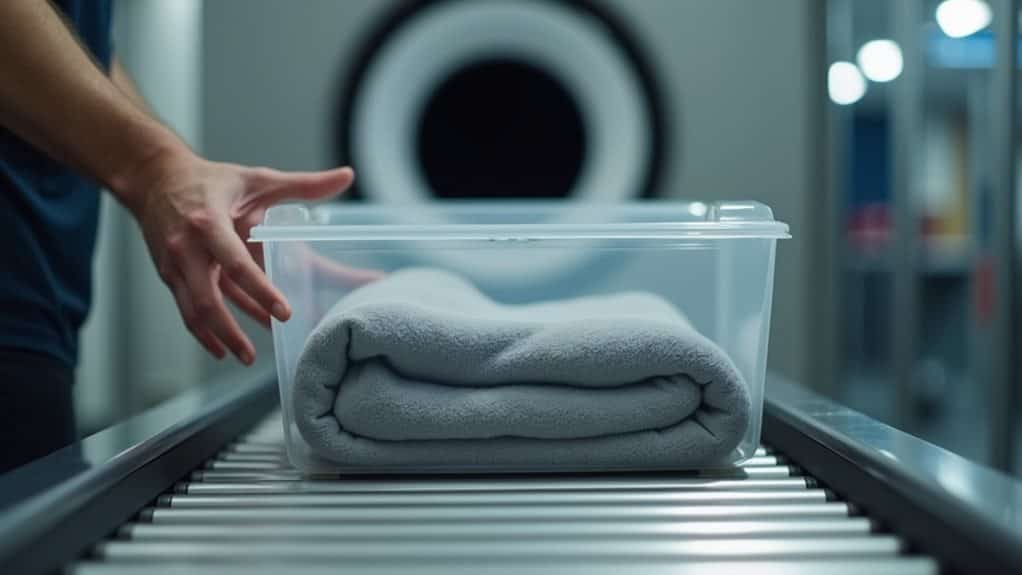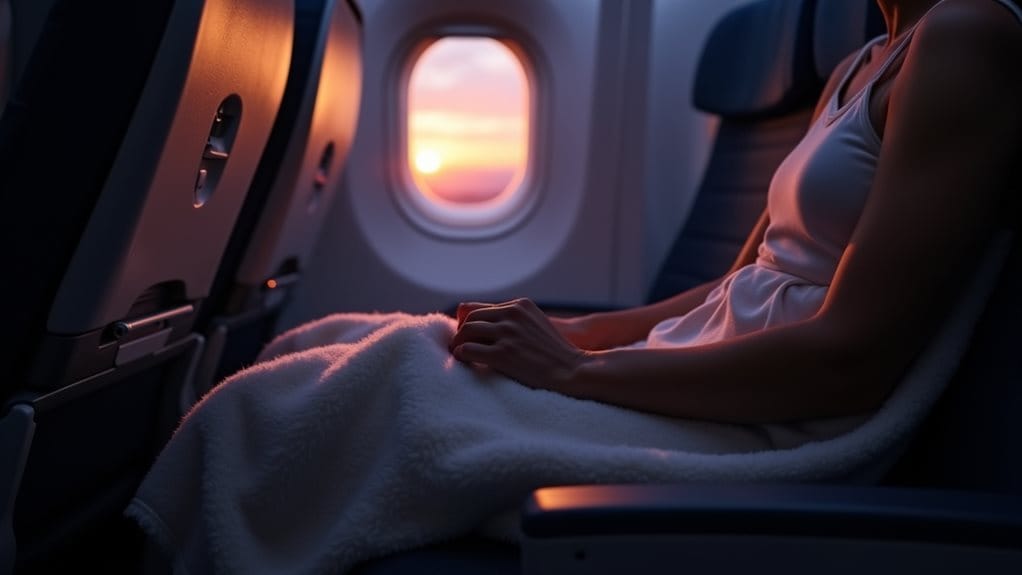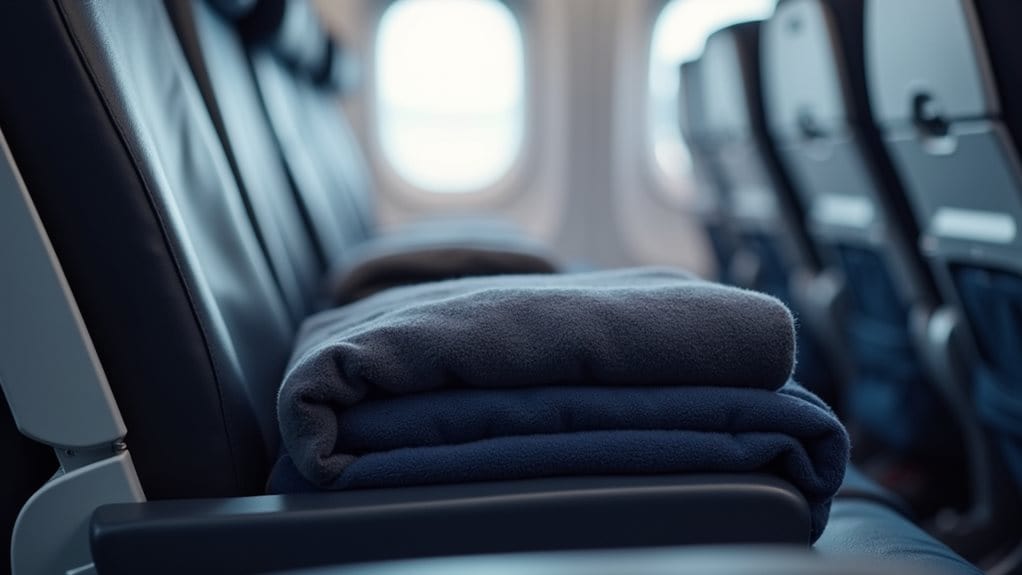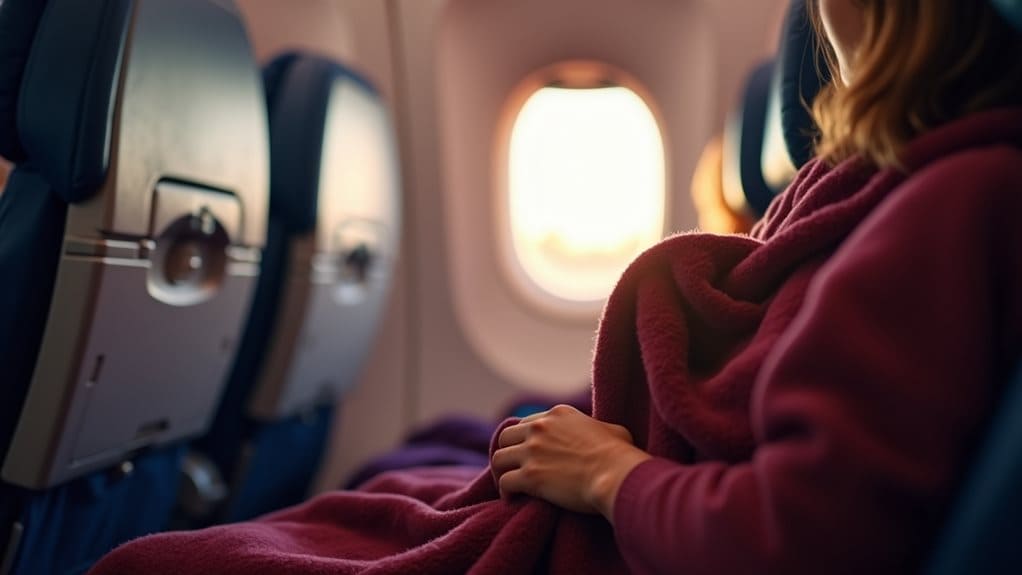You can bring a blanket on a plane in both carry-on and checked baggage without special TSA restrictions. Your blanket must pass through X-ray screening, and bulky ones may require separate inspection by security officers. Most airlines allow personal blankets as part of your carry-on allowance, though size and weight limits vary by carrier. Bringing your own blanket enhances comfort by providing temperature control, better hygiene than shared airline blankets, and familiar fabric that improves sleep quality during flights. Understanding specific airline policies will help you maximize your in-flight comfort.
TLDR
- TSA permits blankets in carry-on and checked baggage without special restrictions, requiring only standard X-ray screening.
- Most major airlines allow personal blankets as part of carry-on allowance, though size and weight limits vary.
- Personal blankets enhance flight comfort by providing temperature control, hygiene benefits, and familiar psychological comfort for better sleep.
- Fleece and merino wool blankets with packable designs offer optimal travel convenience and temperature regulation capabilities.
- Electric blankets are generally prohibited unless battery-operated, while weighted blankets are typically allowed despite carry-on weight considerations.
TSA Security Rules and Screening Requirements for Blankets

When you’re planning to bring a blanket on your flight, you’ll be pleased to know that TSA regulations permit blankets in both carry-on and checked baggage without special restrictions.
However, TSA officers maintain final discretion at security checkpoints. Your blanket must pass through X-ray screening, and you may need to remove bulky blankets for separate inspection. To streamline the screening process, keep your blanket neatly folded and easily accessible for TSA agents to examine if necessary. Additionally, being aware of TSA regulations can help ensure a smoother travel experience.
Airline Policies on Personal Blankets and Onboard Restrictions
While TSA regulations provide the security structure for bringing blankets aboard aircraft, individual airlines maintain their own specific policies regarding personal blankets and onboard restrictions.
Most major carriers permit personal blankets as part of your carry-on allowance, though size and weight limits vary by airline. Checking specific airline restrictions is advised before traveling with your personal blanket. Additionally, be aware that Delta’s 22x14x9 Rule outlines the size limitations for carry-on items, which can impact how you pack your blanket.
Budget carriers often impose stricter carry-on restrictions that may affect blanket allowances.
Why Bringing Your Own Blanket Enhances Flight Comfort

Bringing your own blanket alters your flying experience by addressing three key comfort challenges you’ll encounter at 30,000 feet.
You’ll gain better control over your body temperature as cabin conditions fluctuate throughout the flight, while ensuring you’re wrapped in clean fabric that hasn’t been shared with countless other passengers.
Your personal blanket also creates a familiar, cozy environment that helps you fall asleep faster and stay comfortable during those long hours in cramped airline seats. Additionally, being aware of airline policies regarding personal items can enhance your travel comfort by preventing any last-minute surprises at security.
Temperature Control Benefits
Although aircraft temperature control systems are designed to maintain passenger comfort, cabin conditions can fluctuate considerably throughout your flight, making personal temperature regulation essential for a pleasant travel experience.
You’ll encounter temperatures ranging from 64°F to 88°F, with about 17% of passengers reporting feeling cold despite controls.
Your personal blanket provides immediate, adjustable warmth.
Hygiene and Cleanliness
Beyond temperature considerations, the cleanliness of airline-provided blankets presents significant health concerns that make bringing your own blanket a smart choice.
Airline blankets, particularly on domestic flights, often receive minimal cleaning between uses.
You’ll avoid exposure to bacteria, allergens, bodily fluids, and mold that accumulate on shared blankets, protecting yourself from potential infections and respiratory issues.
Sleep Quality Improvement
While airline seats weren’t designed for ideal sleep, your personal blanket can greatly change your in-flight rest experience through multiple comfort-enhancing mechanisms.
Deep pressure stimulation from weighted blankets reduces cortisol levels and heart rate, promoting faster sleep onset.
Personal blankets also provide essential temperature control, psychological comfort through familiarity, and additional physical support for better posture.
Best Types of Blankets for Air Travel

The fabric and design of your travel blanket can make the difference between a comfortable flight and hours of restless discomfort. Fleece offers lightweight warmth and quick-drying properties, while merino wool provides natural temperature regulation. Look for packable designs with hands-free features like neck snaps, built-in pockets for essentials, and convertible pillow modes for maximum convenience. Additionally, be mindful of TSA guidelines regarding liquid limits, as they can affect your overall packing strategy for comfort items.
Packing and Security Checkpoint Tips for Blankets
Maneuvering airport security with your travel blanket requires minimal preparation, as TSA allows blankets in both carry-on and checked luggage without special restrictions.
Pack your blanket in outer compartments for easy access, since agents may request separate screening. Fold it neatly and arrive early to accommodate potential delays.
Weighted or heated blankets need additional consideration for airline policies.
Managing Cabin Temperature and Cold Air Circulation

Aircraft cabins can feel surprisingly cold during flight, even though airlines target a standard temperature of around 68°F for passenger comfort.
You’ll often notice that cold air circulates continuously through overhead vents and cabin air systems, creating drafts that can make you feel chilly regardless of the set temperature.
Understanding how to position your air vent and manage the cold air flow around your seat will help you stay comfortable, especially when you’ve brought your own blanket for extra warmth.
Cold Cabin Environments
When you step aboard an aircraft, you’ll likely notice that cabin temperatures feel cooler than what you’d expect from a typical indoor environment.
Airlines maintain cabin temperatures between 71-75°F, but you’ll perceive them as colder due to extremely low humidity levels of 10-20% and lack of air movement, which increases evaporative cooling from your skin.
Air Vent Positioning
Beyond the baseline cabin temperature settings, the positioning and design of air vents play a significant role in how cold you’ll feel during your flight.
Airlines strategically place vents throughout different cabin zones to distribute airflow evenly and prevent cold spots.
However, passengers seated directly below poorly positioned vents may experience uncomfortable drafts despite ideal overall cabin temperature.
Electric and Weighted Blanket Considerations for Flying
While standard blankets face few restrictions during air travel, electric and weighted blankets require more careful evaluation due to their unique features and potential safety concerns.
Most airlines prohibit plug-in electric blankets but allow battery-operated versions.
Weighted blankets are generally permitted since they lack electrical components, though you’ll need to assess carry-on weight limits.
And Finally
You’ll find that bringing your own blanket greatly enhances your flight experience while staying within TSA guidelines. Regular blankets pass through security easily, though you’ll need to remove them during screening. Choose lightweight, compact options that fit your carry-on space, and consider airline temperature policies when packing. Avoid electric blankets due to battery restrictions, but weighted blankets under 50 pounds are generally acceptable. Your personal blanket guarantees comfort throughout your trip.



